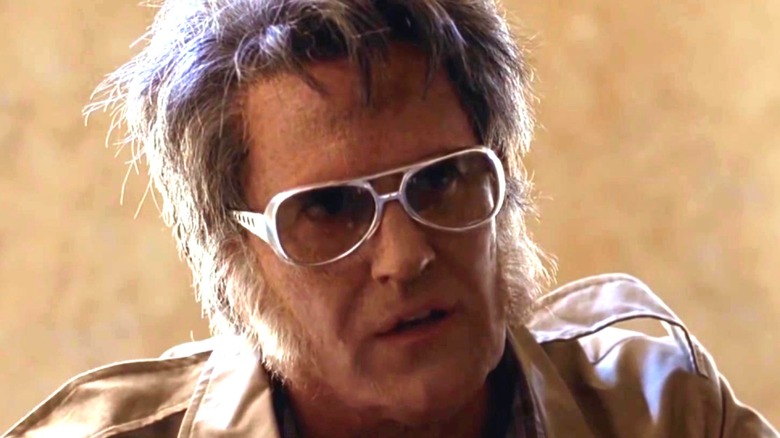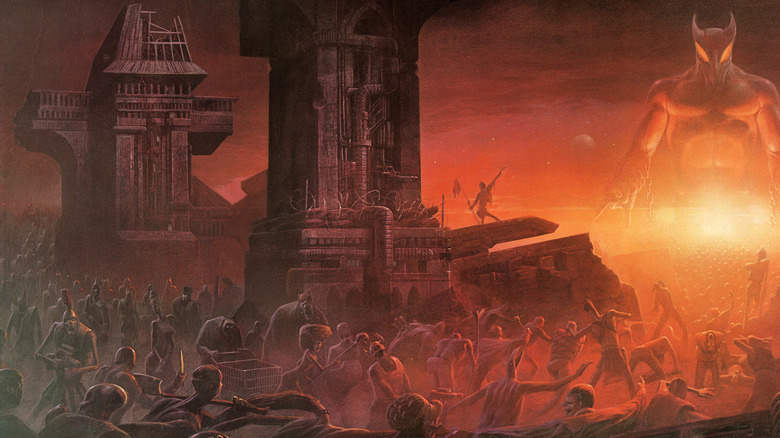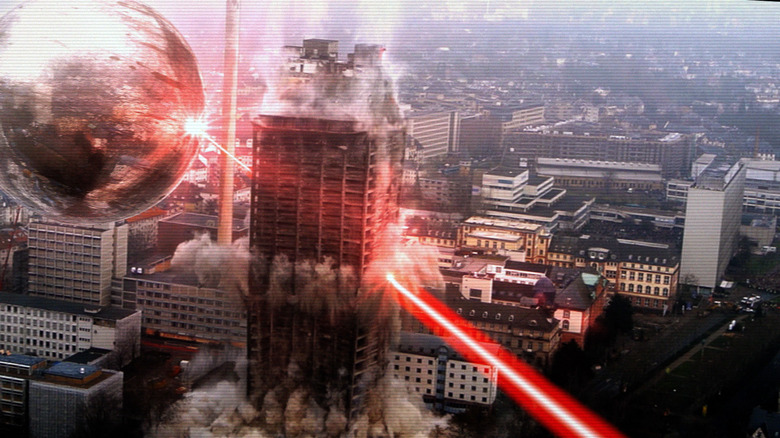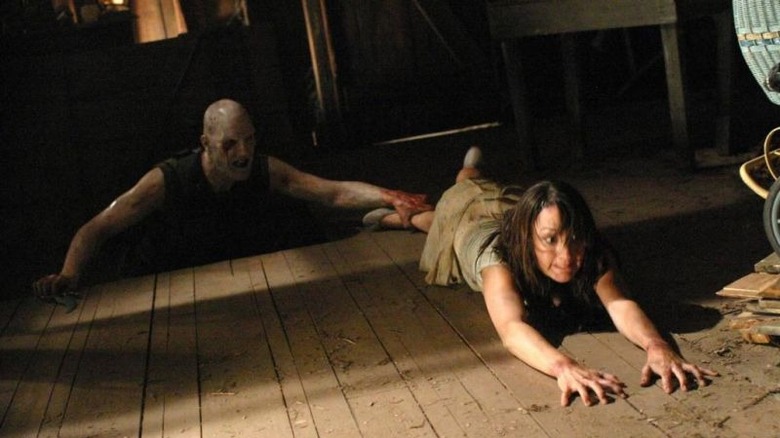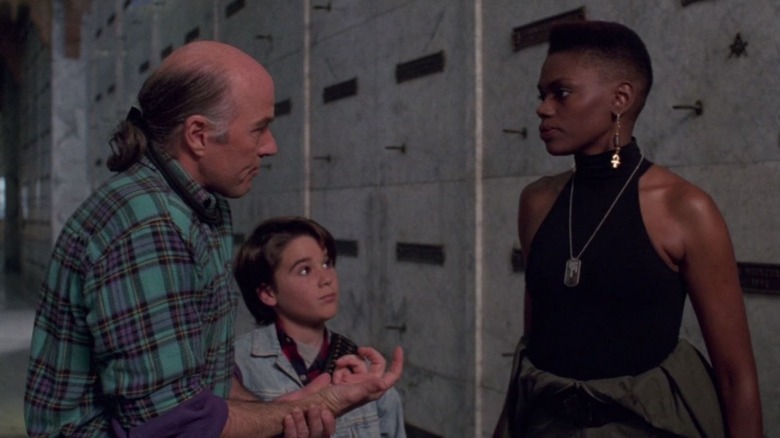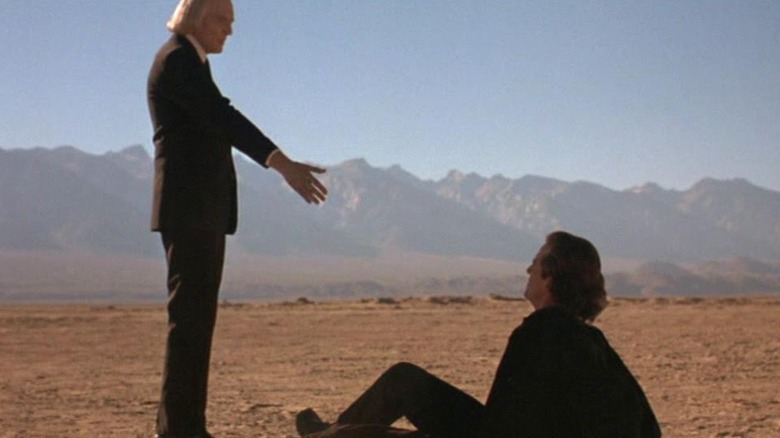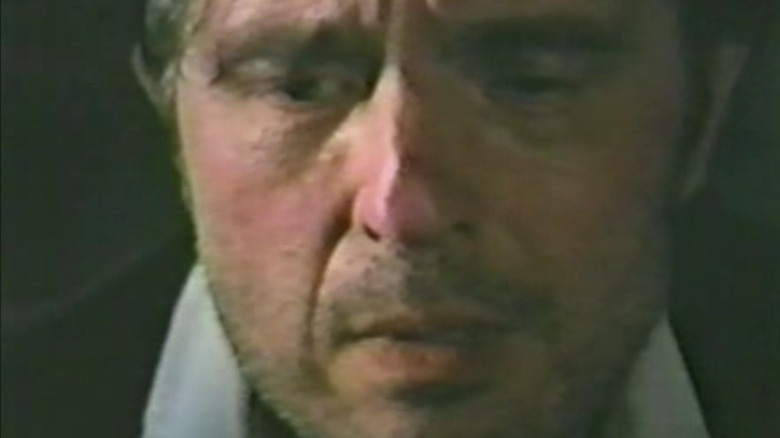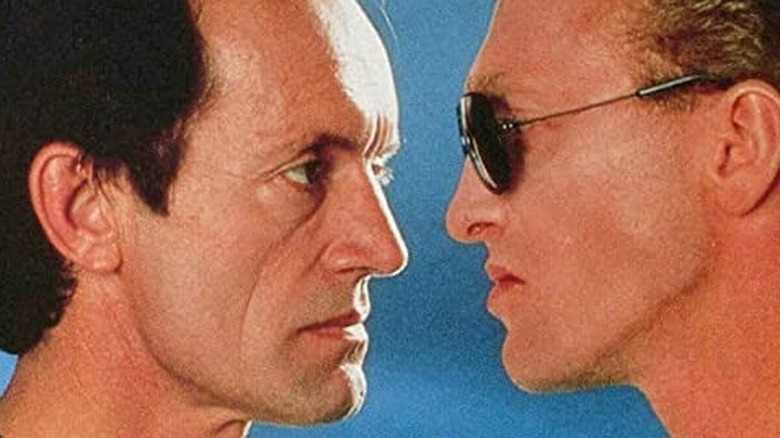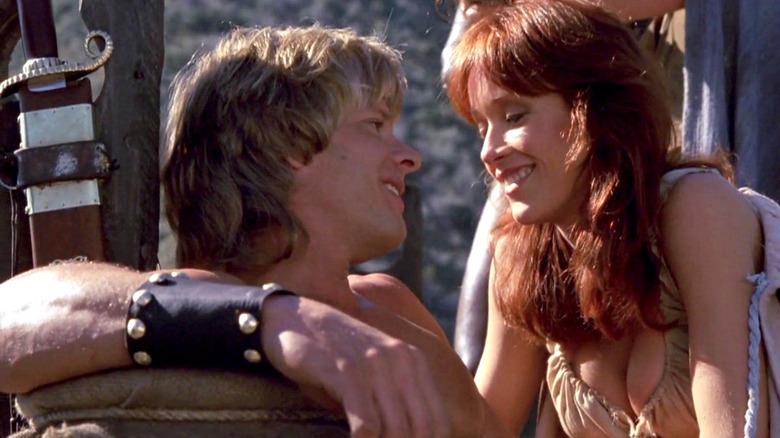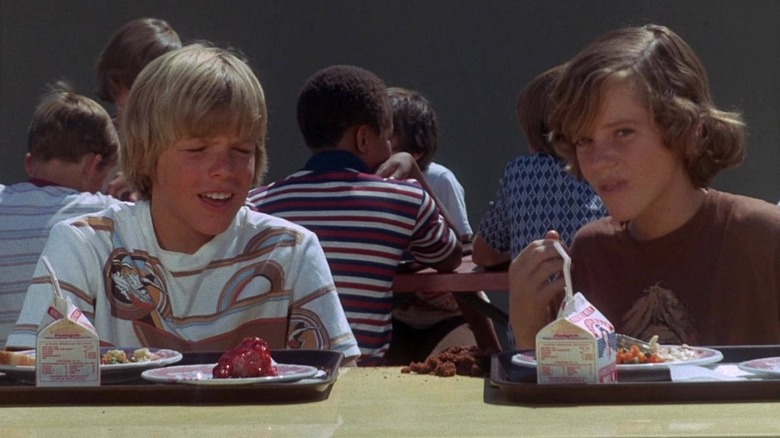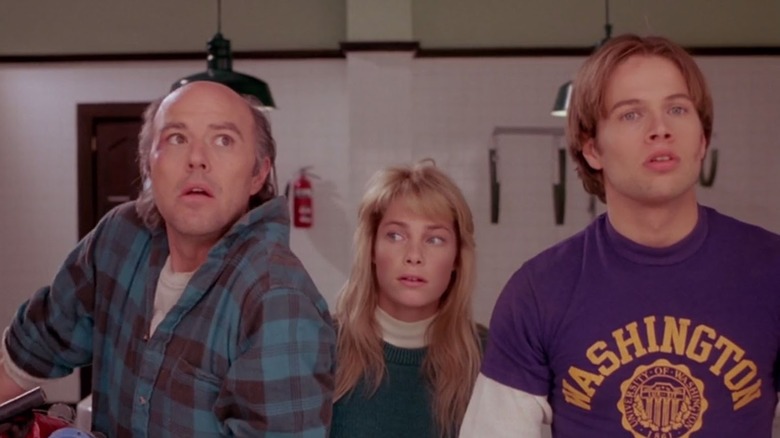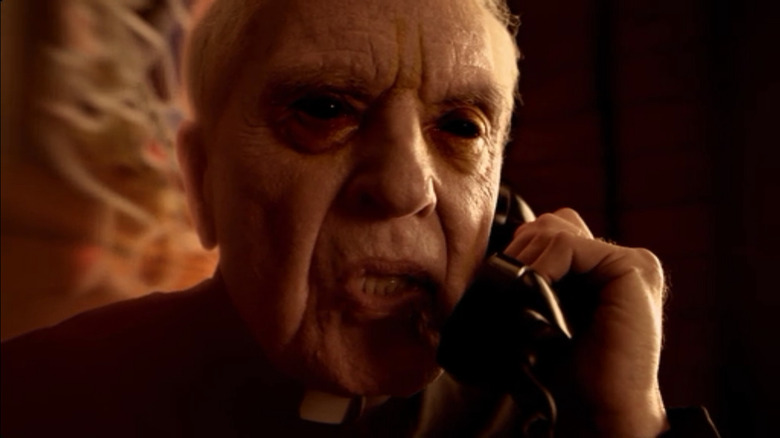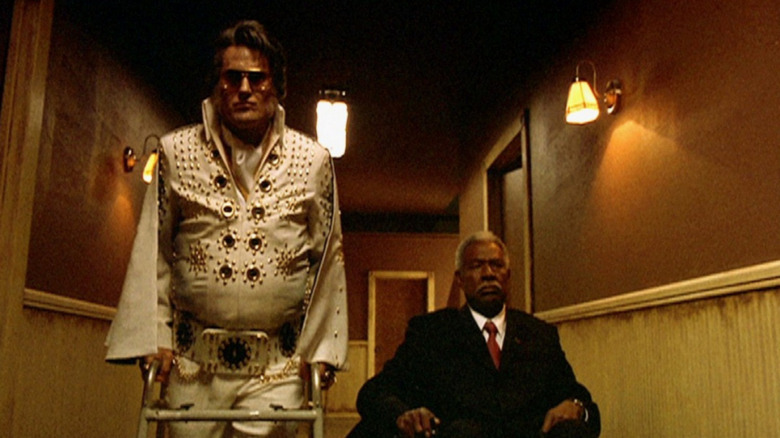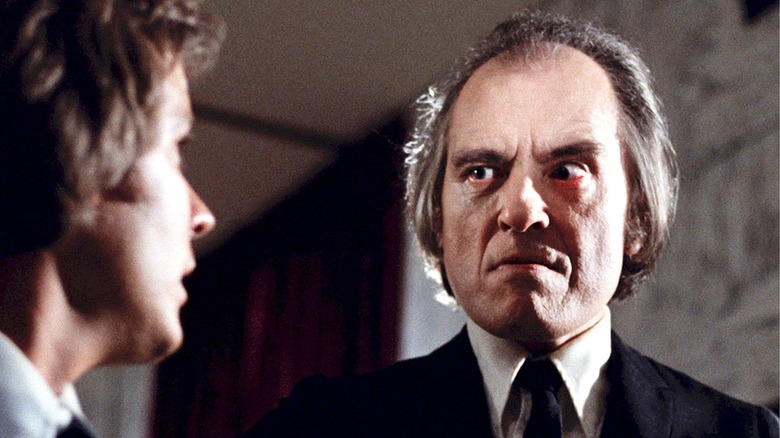All The Films Of Don Coscarelli Ranked Worst To Best
The Halloween season sees many horror film fans exhuming familiar favorites — from Tod Browning's "Dracula" and James Whale's "Frankenstein," to John Carpenter's "Halloween" and Wes Craven's "A Nightmare on Elm Street" — but one filmmaker who always deserves more recognition, especially as the daylight hours grow shorter, is Don Coscarelli.
Coscarelli's resume can be a bit hit-or-miss, but no more so than many of his more celebrated peers, and when he's at his best, regardless of which genre he happens to be working in (and he's worked in a diverse swath of genres), his films can offer hauntingly resonant meditations on aging, death, loss, regret, fraternal bonds, and our respective perceptions of reality.
Not all of Coscarelli's works rank equally highly, but you could do worse than to try any of the films he's written and-slash-or directed, either for Halloween or any other time of the year.
13. Dio: The Last in Line
Don Coscarelli directed the 1984 music video for the title track of heavy metal band Dio's "The Last in Line" by faithfully recreating the aesthetic of its album cover, and reflecting the admittedly unsubtle social commentary of the song's lyrics, written by frontman Ronnie James Dio.
Former "Voyagers!" star Meeno Peluce plays a fresh-faced teenage metalhead delivery boy, whose suburban bike ride to an outwardly shiny office building becomes a literal elevator ride to a post-industrial Hell, as he's herded alongside what appear to be zombies, nuclear mutants, and cyborgs through a cavalcade of tortures conducted via contemporary mass-media. These include a video game arcade where teen players are chained to the cabinets and electrocuted if they lose and a theater full of viewers who have been ball-gagged and fastened to racks, with their foreheads primed for lobotomies.
Coscarelli remained so proud of directing "The Last in Line" that he paid tribute to Ronnie James Dio on Twitter on the 10th anniversary of his death. Both the best and worst one can say about this video is that it looks like an '80s high school metalhead's notebook scribbles come to life.
12. Phantasm: RaVager
Much like the state of Orson Welles' "Mr. Arkadin" prior to its 2006 Criterion edit, there's a significant gulf between the film "Phantasm: RaVager" aspires to be and the film it actually is.
Don Coscarelli co-wrote the script for the franchise's 2016 sendoff with director David Hartman, and while it earns points for making the apparent alternate timelines of the series' canon explicit, it loses some for alternating between various realities with neither any sense of narrative coherence nor the dreamlike atmosphere of the best "Phantasm" installments.
The film's further demerits include CGI that would rate as subpar by the standards of video game cutscenes, and an oppressive "bigger is better" approach to rendering its post-apocalyptic parallel universes, with giant sentinel spheres laying waste to entire cities.
Not even bringing back Kathy Lester as the Lady in Lavender and Gloria Lynne Henry as Rocky for the first time since "Phantasm III: Lord of the Dead" can summon a rousing sense of "the old gang's all back together," since, much like the returns of Han, Leia, and Luke throughout the "Star Wars" sequel trilogy, everyone's appearances in "RaVager" are so disjointed that it feels more like ships passing in the night than a proper reunion.
11. Masters of Horror: Incident On and Off a Mountain Road
Mick Garris' "Masters of Horror" anthology TV series kicked off in 2005 on Showtime with the episode "Incident On and Off a Mountain Road," co-written by Don Coscarelli, Joe R. Lansdale, and Stephen Romano, adapting a short story by Lansdale with Coscarelli directing.
A car accident on a remote forested highway forces lone motorist Ellen (Bree Turner) to evade, then outwit, and finally fight a towering, bald, unnaturally white-skinned serial killer whose muteness gives way to angry growls at the nickname "Moonface" (John DeSantis). While Moonface and his wilderness cabin never transcend generic Leatherface-lite fare, even with the always watchable Angus Scrimm playing the outwardly delusional Buddy, the only captive whose life Moonface has spared, what's far more fascinating are the interspersed flashbacks recounting the breakdown of Ellen's relationship with her survivalist husband, Bruce (Ethan Embry).
Bruce is initially charming enough for Ellen to miss the early red flags of his ruthlessly social Darwinist worldview, but their time together is ultimately reduced to nothing but punishing combat training sessions, which help Ellen develop the strength and strategic thinking to deal with not only Moonface, but Bruce himself. It's welcome to see a victimized woman weaponizing the abuse she's endured from monstrous men, but it leaves a sour aftertaste when she adopts those predatory men's merciless outlooks.
10. Phantasm III: Lord of the Dead
In 1994, Don Coscarelli pulled writer-director double-duty once again on the third "Phantasm" film, but the movie feels more like a spiritual successor to writer-directors Dan O'Bannon and Ken Wiederhorn's two "Return of the Living Dead" films from the '80s. The "splatstick" zombie comedy is reflected in the trio of wisecracking crooks who refuse to stop pestering Reggie (Reggie Bannister), faithful friend to the Pearson family, even after they turn undead, all while Reggie grudgingly acquires an annoying pistol-packing orphan sidekick through his travels.
The tonal break from the original "Phantasm" almost manages to mute the return of A. Michael Baldwin as Mike and Bill Thornbury as his older brother Jody Pearson, as well as the Lady in Lavender (Kathy Lester), none of whom appeared in "Phantasm II." Gloria Lynne Henry makes her impressive debut as fan-favorite Rocky, a tough-as-nails martial artist who catches Reggie's ever-roving eye as she seeks to settle her own score with the Tall Man (Angus Scrimm).
The closest "Phantasm III" comes to recapturing the unsettling eeriness of the original stems from its reveal that each sentinel sphere contains the brain of one of the Tall Man's victims, which leads to both Jody and Mike forging disturbing new connections with the spheres.
9. Phantasm IV: Oblivion
Yes, between "Phantasm III: Lord of the Dead" and "Phantasm IV: Oblivion," I'm assigning a slightly higher ranking to the sequel with the woman who has sentinel spheres where her breasts should be.
When film critic Joe Queenan ranked "Exorcist II: The Heretic" versus "The Exorcist III," he wrote, "Only a Jesuit could tell which of these monstrosities is the worst. And whatever my other failings, I am no Jesuit." My judgment is not nearly so harsh, because, in spite of its isolated splatstick moments, writer-director Don Coscarelli's "Phantasm IV" mostly stepped away from the self-parody of "Phantasm III," interweaving an unabashedly plotless narrative with unaired archival footage from the series' preceding films to produce an ominous, moving elegy to a loving father's worst fears, with Reggie Bannister's Reggie all but openly acknowledged as the surrogate father to A. Michael Baldwin's Mike.
Because he wasn't able to save Jody (Bill Thornbury) — whose brain remains bound in a sentinel sphere — or be there for Mike when he was younger, Reggie fears that Mike might fall under the Tall Man's sway, and become his no-less-malevolent successor. This dark possible future is foregrounded when Mike and Jody discover the Tall Man was himself a kindly 19th century mortician named Jebediah Morningside, whose experimental attempts to connect with the world of the dead destroyed whatever man he once was.
8. Jim, the World's Greatest
Don Coscarelli's first feature film was co-written and co-directed with Craig Mitchell when they were both 18 years old, and their 1976 release plays out like a couple of college students were commissioned to produce an "ABC Afterschool Special" after they saw Dario Argento's Animal trilogy for the first time.
Future soap opera stud Gregory Harrison, in only his third onscreen role, plays the title character of Jim Nolan, a handsome, well-liked, yet socially disconnected high school football player who's essentially a single parent to his younger brother Kelly (Robbie Wolcott), while their divorced traveling salesman father (Angus Scrimm, then still credited as Rory Guy) comes home drunk after extended absences.
What could otherwise come across as a somewhat pedestrian narrative is elevated by haunting (albeit admittedly amateurish) cinematography, a few idiosyncratically random scenes, and the deeply heartfelt portrayal of the bond between the older and younger brother, plus a radical third-act plot development. Not only does Harrison's acting make Jim's love for Kelly feel palpably real, but Scrimm manages to make his neglectful, abusive father character pitiable, as his facial expressions convey how painfully aware he is of his failings as a parent and his weaknesses as a person.
Look for a fun sequence involving Reggie Bannister as a free-spirited ultralight aircraft pilot.
7. Survival Quest
The premise and cast might sound like a direct-to-VHS rental, but writer-director Don Coscarelli's 1989 wilderness thriller benefits from a script that emphasizes empathy and teamwork over toughness and competition, as well as his ability to draw strong performances from both proven genre talents and a few future luminaries.
"Aliens" castmates Lance Henriksen and Mark Rolston are set at odds. Henriksen plays humane mountain man Hank Chambers, who guides the Survival Quest group through outdoor excursions to foster self-improvement. Rolston plays dictatorial soldier-of-fortune Jake Cannon, who subjects the heavily-armed "weekend warriors" of Blue Legion to quasi-military exercises, as both camps explore California's Sierra Madre Mountain.
Hank's crew includes future Academy Award-nominee Catherine Keener as insecure divorcée Cheryl, and her future real-life husband, "Young Guns" star Dermot Mulroney, as alienated convict Gray (they met while making this movie). Jake encourages his Blue Legion to bully Hank's Survival Quest trekkers when they cross paths, but cadet Raider (Steve Antin) takes it further than Jake intended, first shooting Hank, then stabbing Jake and framing Hank, to persuade his Blue Legion teammates to hunt down the rest of Survival Quest.
Beyond the gorgeous on-location nature footage, what's uplifting about this film is that Survival Quest never descends to Blue Legion's kill-or-be-killed ethos.
6. The Beastmaster
Don Coscarelli and Paul Pepperman co-wrote 1982's "The Beastmaster" by loosely adapting Andre Norton's 1959 novel "The Beast Master," with Coscarelli also directing, and the resultant cult classic not only spawned a B-grade film and TV franchise, but also arguably sustained cable channels such as HBO, TBS and TNT enough for Dennis Miller to joke that HBO stood for "Hey, Beastmaster's on."
"The Beastmaster" ostensibly concerns a warrior avenging the deaths of his tribe by using his telepathic ability to communicate with animals, but it's essentially Arnold Schwarzenegger's "Conan the Barbarian" (released the same year!) with the serial numbers scrubbed. Like a KMFDM anthem, or a fast-food cheeseburger, this adventure's appeal lies in its devoutly formulaic mediocrity. It is competently but non-ambitiously okay at delivering what it sets out to do, like a set of IKEA assembly instructions for an actual story.
Before "Game of Thrones" and Peter Jackson's cinematic adaptations of J.R.R. Tolkien, swords-and-sorcery was not a genre certain actors appeared in consensually. John Amos and Rip Torn radiated "I'm too talented for this nonsense" energy as intense as the exposed core of Chernobyl, while Marc Singer (of "V") and Tanya Roberts (of "Sheena: Queen of the Jungle") were exactly talented enough for this material.
5. Kenny & Company
This slice-of-life tale of pre-teen pals in American suburbia in the '70s, both written and directed by Don Coscarelli in 1976, is a woefully overlooked gem, generationally resonant enough to deserve broader recognition. Its plot arc follows 12-year-old best friends Kenny (Dan McCann) and Doug (A. Michael Baldwin), plus their 11-year-old sidekick Sherman (Jeff Roth), through a relatively mundane succession of episodic benchmarks of growing up, from facing bullies to dealing with the death of a beloved family pet and working up the nerve to talk to your first crush.
But both the script and the child actors — Baldwin arguably demonstrates stronger acting chops here than he does in certain installments of the "Phantasm" series — invest the narrative with such authenticity and heart that it practically qualifies as a time capsule of the era.
Reggie Bannister tucks his trademark ponytail under his collar to play Mr. Donovan, the "cool" teacher at Kenny's school, while Terrie Kalbus, who would go on to play the fortuneteller's granddaughter in the first "Phantasm," makes her radiant debut as Kenny's crush Marcy. And Don Coscarelli casts his own mom, Kate Coscarelli, to play Kenny's sensitive and insightful mother, making this film feel more like an informal get-together of friends and family.
4. Phantasm II
It took studio suits nearly a decade to recognize that Don Coscarelli had tapped into something fantastic with the first "Phantasm" film. Even when they finally greenlit a sequel, while Coscarelli wrote and directed the story, the suits were calling the shots.
The studio forbade 1988's "Phantasm II" from including any dream sequences, and required the role of Mike Pearson to be recast from A. Michael Baldwin to the more conventionally appealing James LeGros.
Just as Ridley Scott's nightmarish scenarios of isolation and H.R. Giger's grotesquely organic aesthetics in 1979's "Alien" gave way to James Cameron's focus on militarized technology and overwhelming firepower in 1986's "Aliens," so too did "Phantasm II" dispense with the original film's abstractions to deliver Reggie's signature quad-barreled shotgun and the Tall Man's powerful golden sentinel spheres. "Phantasm" was already a fine film, but it took "Phantasm II" to transform it into a franchise.
3. John Dies at the End
What if, instead of Marvel's Doctor Strange or the Ghostbusters (most of whom at least have doctorates) protecting humanity from supernatural threats, it was an aimless, perpetually traumatized slacker in his 20s and his idiot burnout best friend?
Hopelessly out-of-his-depth David Wong (Chase Williamson) and his recklessly enthusiastic sidekick John (Rob Mayes) routinely battle weird foes ranging from zombie skinheads to monsters made of reanimated meat, but their minds aren't fully blown until they experiment with a drug nicknamed "Soy Sauce" right as they find themselves facing an invasion of cultists from an alternate timeline of human history.
"John Dies at the End," which premiered at Sundance in 2012, benefits from Don Coscarelli directing his own adapted screenplay, based on the eponymous novel by the pseudonymous David Wong (real name Jason Pargin), whose fertile imagination throws a slew of college philosophy thought experiments at his in-story surrogate as tangible life-and-death dilemmas for him to solve. Coscarelli imbues this inventive material with the plummeting pit-of-your-stomach sensation of an intense drug trip gone traumatically wrong, with the able assistance of Williamson's frantic, scrambling-across-the-floor performance as Wong.
A host of genre luminaries fill out the cast, including Clancy Brown (the Kurgan from "Highlander") as a professional spiritual investigator, Doug Jones (the fish-man from "The Shape of Water") as an alien man of mystery, and the Tall Man himself, Angus Scrimm, as an initially benevolent priest. And the film's epilogue is hilariously pitch-perfect.
2. Bubba Ho-Tep
Elvis Presley (Bruce Campbell) faked his death, having switched places with an impersonator who overdosed in his place. President John F. Kennedy (Ossie Davis) didn't die from his attempted assassination, but was instead disguised as a Black man by those who'd sought to get rid of him.
Or maybe they're both just crazy, having succumbed to conspiracy theories they'd cooked up from dementia-addled memories, as friends and fellow residents of a run-down nursing home whose other inhabitants are getting knocked off one by one by an ancient Egyptian mummy.
Whether they're who they believe themselves to be is almost irrelevant, because all they have left are laments over what they wish they'd done differently, with no loved ones to comfort them as they count down however little time they have remaining. Campbell excels at portraying buffoonish caricatures of square-jawed masculinity, but his reaction, as Elvis, when Davis' JFK says, "We weren't there for our kids when they needed us, were we?" still hits like a punch to the gut.
This guilt motivates both men to shed their cowardice and save the souls of their nursing home from the redneck mummy they derisively call Bubba Ho-Tep, in a finale that will leave you laughing out loud, but with a lump in your throat at the same time. Don Coscarelli also directed his own adapted screenplay for 2002's "Bubba Ho-Tep," based on the eponymous 1994 novella by Joe R. Lansdale.
1. Phantasm
"Phantasm" is Don Coscarelli's "Citizen Kane." He wrote, directed, photographed and edited this 1979 independent film, whose cast and crew were mostly amateurs.
After the death of a mutual friend, 13-year-old Mike Pearson (A. Michael Baldwin) tries to convince older brother Jody (Bill Thornbury) and family friend Reggie (Reggie Bannister) that something suspicious is going on at the Morningside Cemetery, whose mortician is a towering, scowling, sinister figure all three come to know as "the Tall Man" (Angus Scrimm). Mike and Jody's parents are already dead, and Jody confides in Reggie — without knowing that Mike is listening in — that he plans to leave town, so it's easy to interpret Mike's hallucinatory fears as flights of imagination inspired by his desire to keep what remains of his family together.
Coscarelli heightens this sense of surrealism by recreating the stylistic tics of Italian giallo horror, as characters morph into each other, riddles are solved through seemingly stream-of-consciousness associations, and what little plot there is proceeds from the sort of logic that only makes sense in our dreams.
The actors' relative inexperience makes their performances all the more emotionally genuine, with the standouts being Bannister as Reggie, essentially playing himself as a good-time buddy who'd lay down his life for his friends, and Scrimm as the Tall Man, who got as much mileage out of cocking an eyebrow and growling the word "BOY" as Robert Englund did from wielding his razor-fingered glove as Freddy Krueger.
